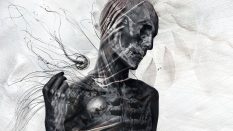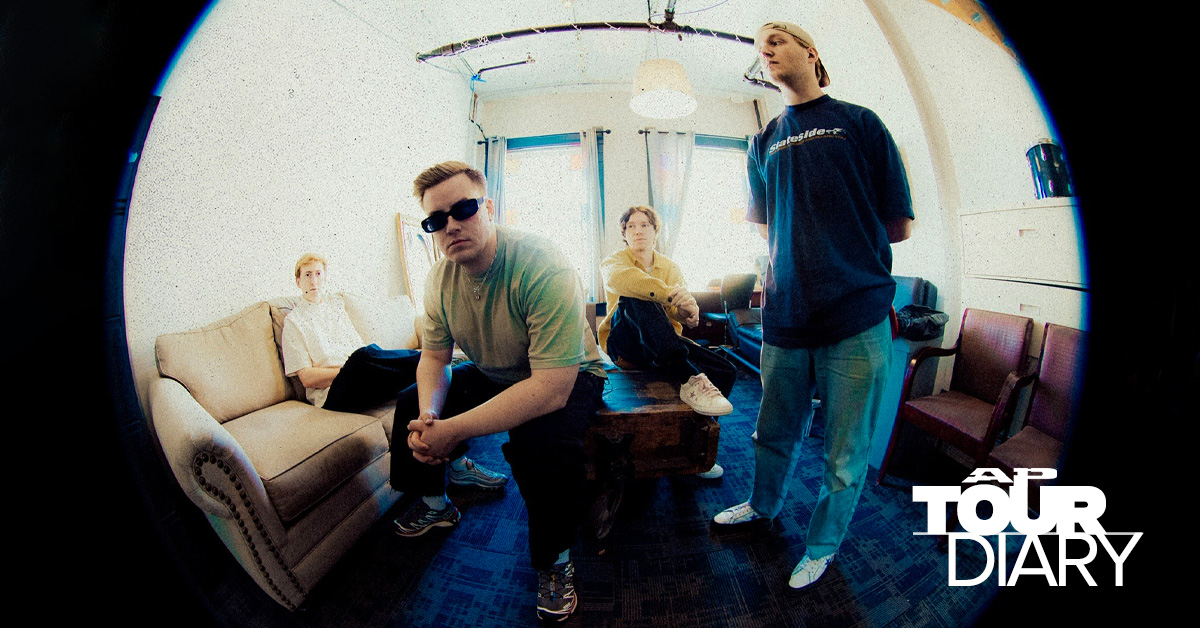
Deconstructing Interference #4

…
Welcome to the fourth edition of Deconstructing Interference! In this entry you will find out about historic album, containing compositions from the ‘80s to today, experimental techno duos, collaborations between extreme mathcore bands and Onkyo Music Movement pioneers, avant-jazz/math death metal curators, odes to the ‘90s rave culture, JK Broadrick’s latest utopian visions, minimal dark electronic trips and the sounds produced by old cathode ray TV sets and VHS.
If you would like to be considered for this column, drop me an email: [email protected]
…
In Aeternam Vale – Pink Flamingos
Initially founded in 1983, as a band, In Aeternam Vale followed the synth punk movement at the time. Laurent Prot, leader of the band made the decision to continue this venture on his own. With a diverse sound, taking on elements from PIL’s punkish latitude (Prot’s live shows are a testament to that,) Kraftwerk’s persistence of precision, along with experimental dance concepts and Coil’s alchemical visions, Prot remained prolific through the ‘80s and into the ‘90s. His releases have become sparser, but the return with a triple LP in Pink Flamingos showcases that he has not lost his touch when it comes to experimental electronic explorations.
At first it might seem that Pink Flamingos is a compilation album, but that notion is false. What Prot has done here is found material that he composed for In Aeternam Vale through the years, ranging from his ‘80s and ‘90s era to today’s more abstract incarnation of the project. It is a testament to the continuity of his work how naturally the tracks across three different decades can be contained together in the same full-length and produce such a coherent result. Some of this music was written from an excited 25 year old, like the playful “176” and “Clovenzorex”. As the tracks venture into the ‘90s the more adventurous nature of Prot comes to the forefront, with “Congestion Cosh” dipping its toes in the post-techno experimental territory and “Hole” completely embracing it. Finally the ‘00s fall completely in the experimental, off-kilter space, with the more apparent addition of noise and drones creating abstract domains filled with feverish dreams. Still moments such as “B,” one of the tracks originating in the ‘00s era for Prot, reveal the true evolution of his style, containing elements across all eras.
…
SHXCXCHCXSH – SsSsSsSsSsSsSsSsSsSsSsSsSsSsSs
This experimental techno duo from Sweden introduces the new chapter of stop motion rhythmic maximalism. Soft and dreamy soundscapes appear at first, giving us just a glimpse of the sonic palette at the duo’s disposal, while the distortion leaves craters in its path.The coalition of those two worlds that gives this record both a constant volatile state and its intriguing allure.
The experimental outlook is also apparent, with the use of effects from delays to the noise injections. Ample distortion and a touch of glitch set the stage, while the mood of the album switches between exciting and upbeat to more melancholic and transcendental.
…
Many Arms & Toshimaru Nakamura – s/t
Now, this is a team-up for this ages. On one hand you get Many Arms’ punk and free-jazz in equal parts filled with a John Zorn-ian improv sense and a lot of math metal qualities. On the other one of the pioneers of the Onkyo Music Movement, Toshimaru Nakamura. Giving more emphasis to the texture of sound rather the musical structure or sense of melody, Nakamura makes use of a mixing board set in a feedback loop (input to output) which he manipulates through various effects.
The result of these two forces is a multi-faced album. Chaotic explosions and free-jazz fury wash over with cacophonous waves, devoid of form at times, constantly morphing to the artists’ whim.The improv side can be felt, and with a jazz aesthetic providing a less distorted, touch smoother, approach. It is all summed up in the magnificent closing track, as the two artists work together with a set progression in mind, brilliantly navigating through noise and math rock, starting from loose notions and building to devastating storms.
…
Period – 2
Charlie Looker (guitars) and Mark Pride (drums & percussion) are veterans of numerous collaborations. Their project Period, released a self-titled album back in 2006, and now make a return with its unique blend of experimental metal, prog/art rock, jazz and acoustic elements. With the help of three excellent musicians in Chuck Bettis (vocals & electronics,) Darius Jones (alto sax) and Sam Hillmer (tenor sax) as well as producer Colin Marston, they exploit their technical abilities to a new level.
The album itself starts off with a distinct experimental metal sense, bringing to mind the works of Dysrhythmia, with the constant pushing and pulling of rhythmic structures and the weight of their heavy riffs. This is not the sole direction that the band undertakes. More aggressive moments moving head on towards death metal, as “Four” and “Six” reveal Bettis’ full capabilities on causing havoc, with his extreme voice over the heavy jazz-influenced instrumentation, bringing to mind the works of Atheist. Complete with smooth jazz improvs, acoustic guitar and hypnotic sax input, caustic chaos with complex rhythm structures alongside drone elements. 2 is a melting pot.
…
D. Carbone – Ravers
Stepping further away from his slower previous installations, D. Carbone switches to more upbeat, extreme and aggressive methodologies with Ravers. Dedicated to the ‘90s culture, this mini-album makes use of the energy generated from repetition, alongside the effect of noise and acid elements within the industrial techno mix. Heavy beats and insane basslines make an appearance, filled with spasmodic outbreaks. “Hard Vision” pays tribute to that acid techno approach, while “Space Journey 1171” finds a balance between hallucinogenic themes and space-y soundscapes. Abrupt outbreaks of noise in “Orius” and more abstract notion in “ESX” sum up this trip back to the ‘90s.
…
JK Flesh – Rise Above
JK Broadrick needs no introduction, but his JK Flesh moniker is quite new. The project started in 2012 with the release of Posthuman, and was followed with a fantastic split with Prurient in 2013. Broadrick stated that JK Flesh was the outlet for his hardest beats, his love of noise and an ambiance filled with threat and foreboding. It is not difficult to comprehend that notion as soon as the claustrophobic sounds of “Tunnel” creep in, the distorted beats of “Defector” causing quakes with every pummel and the bass drive of “Trinity.” The breaks from heavy beats into more ambient territories is equally unnerving. Broadrick’s subtle touch can bring a profound sense of dread any moment, going as far as full-on noise in “Defector”, or bringing the industrial weight and groove of Godflesh in “Conquered” and “Cast”.
…
Oneirogen – Convivium
Mario Diaz de Leon is definitely an interesting character. An active composer of modern classical music (de Leon got a 2016 commision from the LA Philharmonic) he is also the frontman of death metal act Luminous Vault. However, it is Oneirogen, his solo experimental electronic project that provides a better insight on the more personal side of his work.
Stepping away from the sound of his two first full-lengths, Hypnos and Kiasma, his latest release, Convivium, follows the minimal path first introduced in Oneirogen’s 2015 EP, Plenitude. The metal influences have retreated into the background. Piercing synths form different soundscapes, from dream states and underwater motifs to solitary moments of solace. The metal side is still present to a certain extent, and with the inclusion of abrupt noise, it is able to produce tormenting moments, blurring the boundaries between by the creative use of effects.
…
Jesse Osborne Lanthier & Grischa Lichtenberger – CLSM
Lanthier and Lichtenberger collaborated for the CLSM (Conversations Sur Lettres Mortes) in 2014 at the MAC (Musée d’art contemporain de Montréal,) generating sounds using various cathode ray TV sets and VHS units. Apart from the innovative aspect of this approach, the use of such devices gives a childlike, exploratory sense to this work as the duo tinkers with obsolete items in an attempt to unveil the complex mechanics of reality.
The feedback and noise that the machinations of the duo is able to achieve are multi-faceted, creating creepy and unsettling environments, by simple means such as a constant background noise. As an extra, three great artists contribute remixes for this work. Low Jack with his intense breakbeat energy, Gabor Lazar and his extreme beat fragmentation and Rabit with his evolved take on grime and hardcore.
…








![Bad Omens announce new album CONCRETE JUNGLE [THE OST]](https://www.altpress.com/wp-content/uploads/2024/04/17/BadOmens-CROP_2024_JW_0619_Final_V1.jpg)


